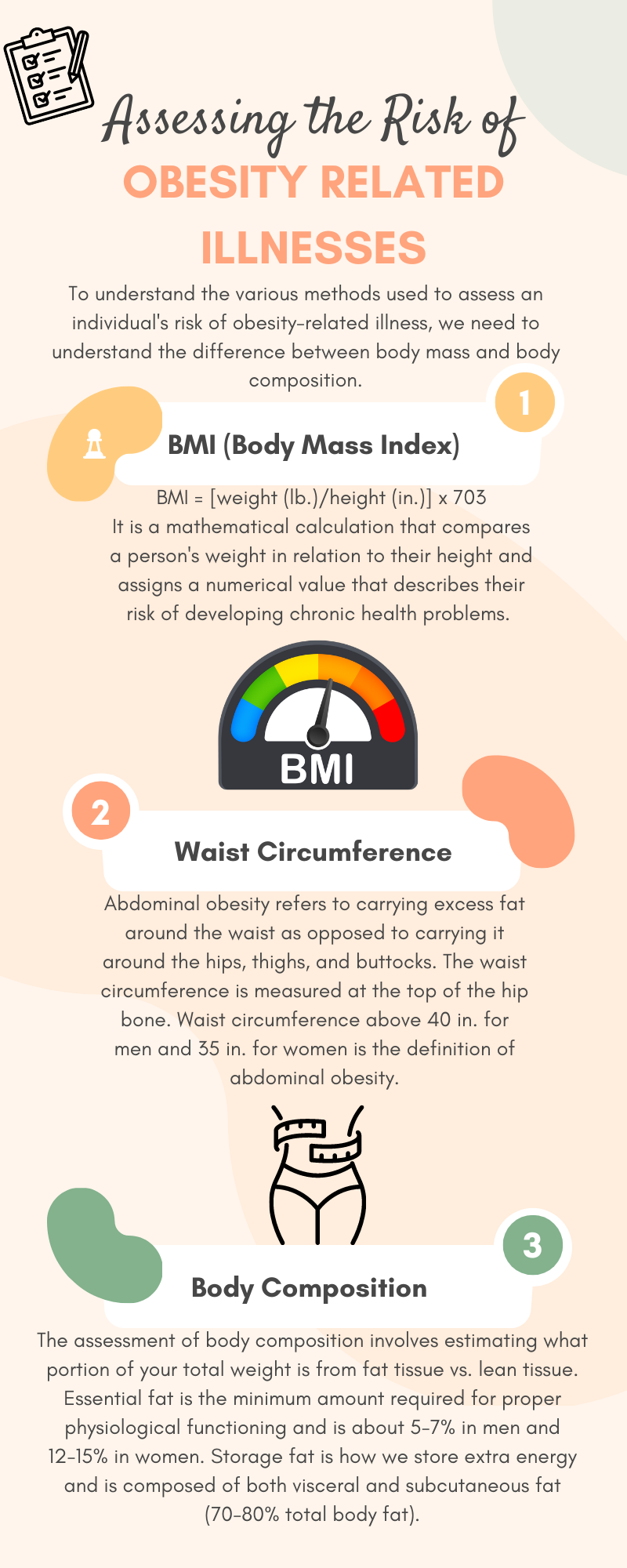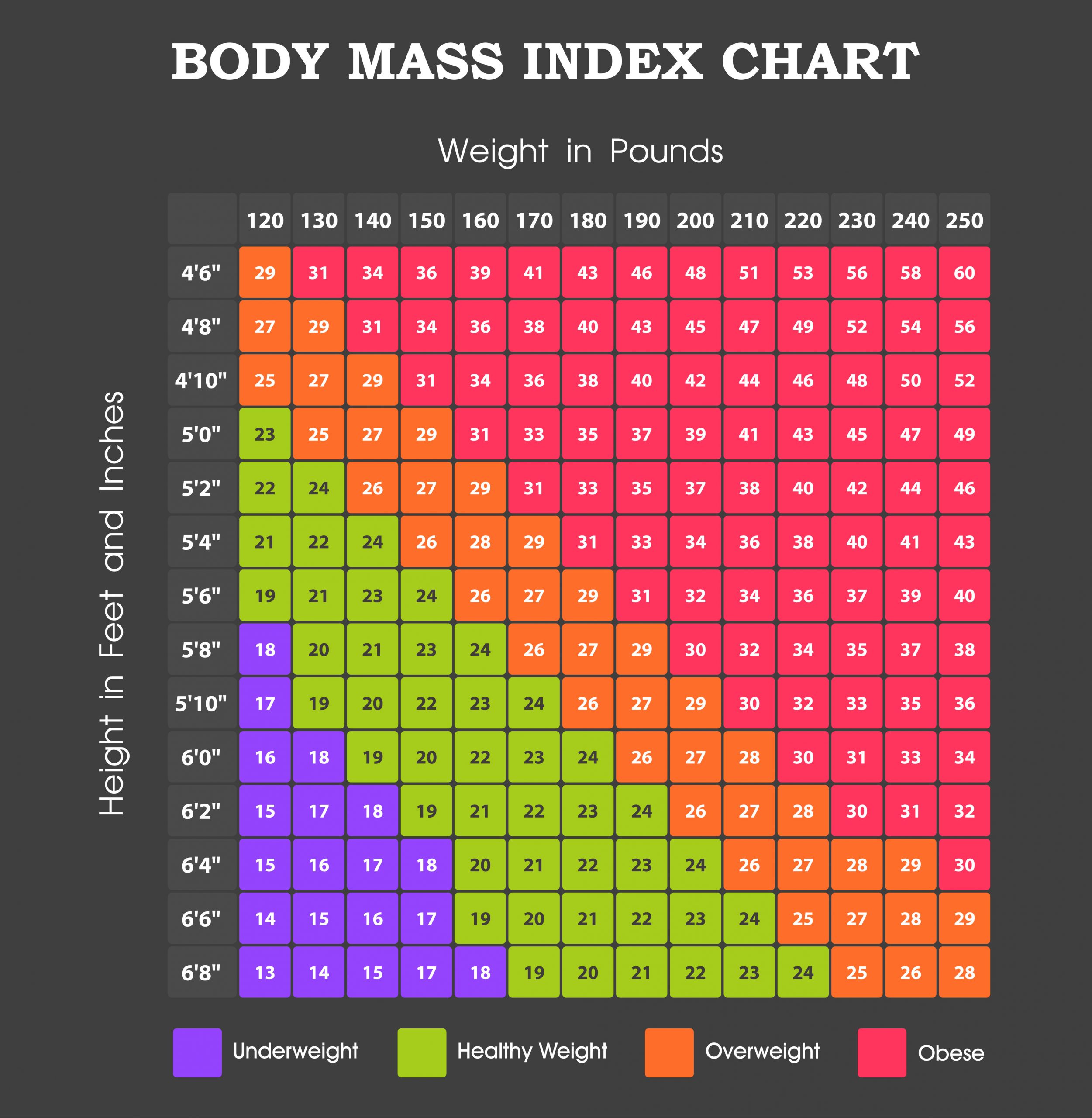9.2 Body Mass Index (BMI) and Waist Circumference
In order to understand the various methods used to assess an individual’s risk of obesity-related illness, we need to understand the difference between body mass and body composition. Body mass refers to the amount of matter or material that makes up an individual’s body and is measured by how much the person weighs. Body composition refers to the makeup of an individual’s body in regard to fat mass and fat free mass. Fat mass is all of the fat material in the body, the largest component being adipose. Fat free mass, or lean mass, is composed of all other tissues that are not fat, skeletal muscle being the most prominent. Some methods of assessing overweight and obese use weight and others use body composition. In the next two sections, we will discuss the most commonly used methods of assessing an individual’s risk of obesity-related illness. It’s important to realize that every method of assessing an individual’s risk of obesity related illness has both pros and cons and there is no one method that will capture an individual’s risk of obesity related illness perfectly. You can think of all of these methods as screening tools, not diagnostic tests
Figure 9.1 Assessing Risk of Obesity Related Illness

Body Mass Index
BMI is a calculation developed by a Belgian mathematician in the 1800’s that compares a person’s weight in relation to their height, and assigns a numerical value. That numerical value has then been used to categorize and describe their risk of developing chronic health problems associated with excess body fat. BMI is calculated using the following formula:
BMI = [weight (lb) ÷ height2 (in)] x 703
BMI is not sex specific so it is considered applicable to both men and nonpregnant women of all race and ethnic groups. However, it is important to note that the formula was developed using European men in the 1800’s and applicability for other populations has been questioned. BMI is meant to be used as a screening tool for potential health problems due to excess fat but it does not measure body composition and it may not be accurate for many individuals. This is particularly true for athletes. It is very common for athletes to fall into the overweight and obese categories due to the fact that they weigh more because they have a lot of muscle. Excess body weight is only unhealthy if it is a result of excess body fat. Conversely, there is the “skinny-fat” individual that has a “healthy” BMI and is at a “healthy” weight but has very little muscle mass and high amounts of body fat and thus are thin on the outside but fat on the inside. This is often seen in people who do not exercise and who go on starvation or very low calorie diets to lose weight. This type of weight loss is typically associated with loss of muscle mass and is not considered healthy. Therefore, BMI is not a great predictor of an individual’s risk of obesity related disease. BMI is better used as a tool to track changes in weight at a population level to make public health decisions or identify drastic changes in an individual’s body weight that may signal an underlying health problem.
Figure 9.2 BMI Chart

Table 9.1 BMI Ranges
| Category | BMI value |
| Underweight | < 18.5 |
| Normal weight | 18.5-24.9 |
| Overweight | 25-29.9 |
| Obese | 30-34.5 |
| Severely Obese | ≥ 35 |
Waist Circumference
Where you store your fat is just as, and possibly more, important as how much fat you have. Abdominal obesity refers to carrying excess fat around the waist as opposed to carrying it around the hips, thighs, and buttocks. Fat that accumulates in the abdominal region is referred to as visceral fat and surrounds the organs in your chest and stomach cavity. This type of fat distribution is associated with higher risk of heart disease, diabetes, and hypertension. An easy way to assess this is to measure your waist circumference. A waist circumference is measured at the top of the hip bone, generally at approximately the same level as the navel. A waist circumference greater than 40 inches for a man and 35 inches for a woman is the definition of abdominal obesity and an indicator of increased risk of obesity-related illness. Of course, this is just a screening tool and may not be accurate for very large or very small individuals.
Figure 9.3 Waist Circumference

Table 9.2 Recommended Ranges for Waist Circumference
| Healthy | Unhealthy | |
| Men | 40 inches or less | More than 40 inches |
| Women | 35 inches or less | More than 35 inches |
Abdominal obesity is more common in men, postmenopausal women, Hispanic or African-American women, and obese individuals. Furthermore, people with this type of body fat storage are at higher risk for metabolic syndrome; a deadly combination of abdominal obesity, high blood pressure, insulin resistance, and abnormal cholesterol levels. In general, a person who has metabolic syndrome is twice as likely to develop heart disease as someone who does not have metabolic syndrome. In addition, people with this condition have five times more risk of developing diabetes.
Media Attributions
- Assessing the Risk of Obesity Related Illnesses © Natalie Fox is licensed under a CC BY (Attribution) license
- BMI Chart © Adobe Stock is licensed under a All Rights Reserved license
- Waist Circumference © Adobe Stock is licensed under a All Rights Reserved license
